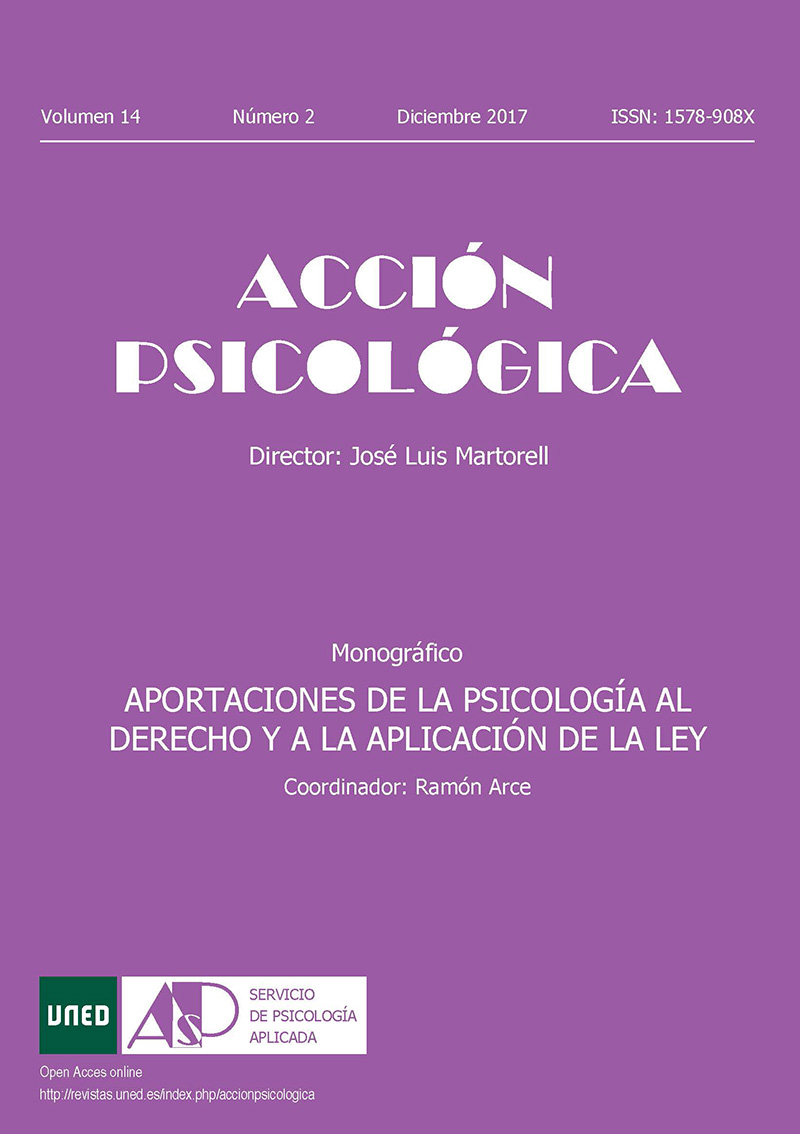Children's Understanding of Emotion in the System of Care
DOI:
https://doi.org/10.5944/ap.14.2.19365Keywords:
system of care, attachment system, child's understanding, internal working modelAbstract
The mother-child relationship has traditionally been studied from the perspective of attachment theory. But in addition, they are a psychological and social phenomenon to which the child gives meaning and tries to understand. To explore the child's understanding of this dimension of the relationship, we interviewed 85 children between 7 and 9 years old through a semi-structured interview with four stories, in which the Attachment System and the System of Care were related. The analysis of the children's responses shows that 97 % attribute discomfort in the mother in relation to the experience of threat of the child. Children of these ages already have an understanding of the Mother's System of Care in connection with the child's attachment system. The responsibility and empathy of the mother are part of the responses of children of these ages as activators of their behavior of care and protection for the child. Children´s representations can be organized at increasingly sophisticated and complex levels of understanding. Knowing the feelings and motivations that children attribute to the mother in her role of primary caregiver and the child's vision of the emotional laws that govern affective mother-child relationships, can offer us new perspectives on how attachment relationships are built and be useful in the detection and intervention in unhealthy attachments, in both members of the dyad.
Downloads
References
Ainsworth, M. D. S. (1985). Patterns of Infant-Mother Attachments: Antecedents and Effects on Development. Bulletin of The New York Academy of Medicine, 61, 771-791
Bell, D. C. (2010). The Dynamics of Conection; How Evolution and Biology Create Caregiving and Attachment. New York, NY: Lexington Books.
Bell D. C. (2012). Next Steps in Attachment Theory. Journal of Family Theory & Review, 4(4), 275-281. https://doi.org/10.1111/j.1756-2589.2012.00135.x
Bell, D. C. y Richard, A. J. (2000). Caregiving: The Forgotten Element in Attachment. Psychological Inquiry, 11(2), 69-83. https://doi.org/10.1207/S15327965PLI1102_01
Bowlby, J. (1969/1982). Attachment and loss, Vol. I, Attachment (2ª ed.). New York, NY: Basic Books.
Bowlby, J. (1973). Attachment and loss, Vol. 2, Separation: Anxiety and Anger (Trad. Cast. La separación afectiva, Buenos Aires, Paidós, 1976). Londres, UK: Hogarth Press
Clarke-Stewart, K. A., Goossens, F. A., Allhusen, V. D. (2001). Measuring Infant-Mother Attachment: Is the Strange Situation Enough? Social Development, 10 (2), 143-168. https://doi.org/10.1111/1467-9507.00156
Crittenden, P. M. (1998). Dangerous Behavior and Dangerous Contexts: A 35-year Perspective on Research on the Developmental Effects of Child Physical Abuse. En P. K. Trickett y C. J. Schellenbach (Ed), Violence Against Children in the Family and the Community (pp. 11-38). Washington, DC: American Psychological Association
Delius, A., Bovenschen, I. y Spangler, G. (2008). The Inner Working Model as a "theory of attachment": Development during the Preschool Years. Attachment & Human Development, 10(4), 395-414. https://doi.org/10.1080/14616730802461425
Delval, J. (2000). Sobre la naturaleza de los fenómenos sociales. En K. Korta y F. García Madruga (Comps). Palabras. Víctor Sánchez Zavala in memoriam [Words. Víctor Sánchez Zavala in memoriam] (pp. 95-122). Bilbao, España: Servicio editorial de la UPV-EHU.
Delval, J. (2007). Aspectos de la construcción del conocimiento sobre la sociedad [Aspects of the construction of knowledge about society]. Revista de Investigación en Psicología, 10(1), 9-48.
Frijda, N. H. (2008). The Psychologists´ Point of View. En Lewis, M, Haviland-Jones, J. y Feldman, L. Handbook of Emotions (pp. 68-87). Nueva York: Ed. Guilford.
George, C. y Solomon, J. (1996). Respresentational Models of Relationships: Links between Caregiving and Attachment. Infant Mental Health Journal, 17(3) 198-216. https://doi.org/10.1002/(SICI)1097-0355(199623)17:3%3C198::AID-IMHJ2%3E3.0.CO;2-L
George, C. y Solomon, J. (2008). The Caregiving Sistem. A Behavioral Sistems Approach to Parenting (2ª ed.). En J. Cassidy y P. R. Shaver (Eds.), Handbook of Attachment: Theory, Research and Clinical Application (pp. 833-856). Nueva York, NY: Guilford.
Harris, P. L. (1992). Los niños y las emociones [Childens and emotions]. Madrid, España: Alianza Psicología Minor
Kalish, W. C. y Lawson, C. A. (2008). Development of Social Representations: Early Appretiation on Roles and Deontic Relations. Child Development, 79(3), 577-593.
Main, M. (1991). Metacognitive Knowledge, Metacognitive Monitoring, and Singular (coherent) vs. Multiple (incoherent) Models of Attachment: Some Findings and some Directions for Future Research. En P. Marris, J. Stevenson-Hinde y C. Parkes (Eds.), Attachment Across the Life Cycle (pp. 127-159). Nueva York, NY: Routledge.
Main, M., Kaplan, K. y Cassidy, J. (1985). Security in Infancy, Childhood and Adulthood: A Move to the Level of Respresentation. En I. Bretherton y E. Waters (Eds.), Growing Points in attachment theory and research. Monographs of the Society for Research in Child Development, 50(209), 66-104. Chicago, IL: University of Chicago Press.
Mikulincer, M. y Shaver, P. R. (2005). Mental Representations of Attachment Security: Theoretical foundation for a Positive Social Psychology. En M. W. Baldwin (Ed.), Interpersonal cognition (pp. 233-266). New York, NY: Guilford Press.
Piaget, J. (1926). El método clínico. Traducción de la introducción de La representación del mundo en el niño. En J. del Delval (Comp.) Lecturas de psicología del niño, vol I [Readings of child psychology]. Madrid, España: Alianza.
Solomon, J. y George, C. (1996). Defining the Caregiving System: Toward a Theory of Caregiving. Infant Mental Health Journal, 17(3), 183-197. https://doi.org/10.1002/(SICI)1097-0355(199623)17:3%3C183::AID-IMHJ1%3E3.0.CO;2-Q
Solomon, J., y George, C., (2000). Toward an Integrated Theory of Maternal Caregiving. En J. Osofsky y H.E. Fitzgerald (Eds.), WAIMH Handbook of Infant Mental Health, Vol. III: Parenting and Child Care (pp 323-368). Nueva York, NY: Wiley.
Walsh, T. M., Symons, D. K. y McGrath, P. J. (2004) Relations between Young Children´s Responses to the Depiction of Separation and Pain Experiences. Attachment & Human Development, 6, 53-71.











